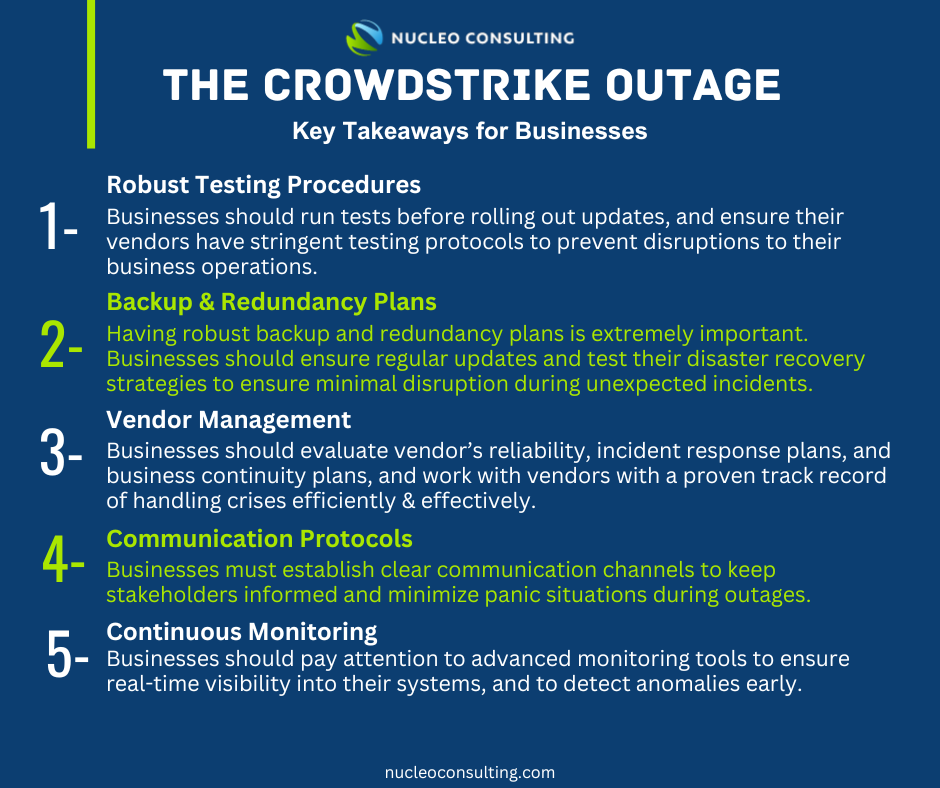The Microsoft-CrowdStrike Outage: What Happened, Its Impact, and Lessons for Businesses
As reported in recent tech news, a significant outage involving CrowdStrike, a leading cybersecurity company, has captured global attention.
CrowdStrike is widely known for its advanced threat intelligence and endpoint protection solutions, which are used by organizations worldwide to safeguard their digital assets. The outage, caused by a software update, led to widespread disruptions by causing Microsoft Windows operating systems to crash. This IT outage has impacted business operations globally, affecting flights, banking, and other sectors, and is described as the “largest IT outage in history.“
Microsoft has been actively assisting its customers through this crisis, highlighting the collaborative efforts within the tech community to mitigate the impact of such incidents. This event not only affected countless organizations but also highlighted essential lessons for businesses relying on cloud services.
Let’s break down what happened, its impact, and what businesses can learn from this event.
What Happened?
On 19 Jul 2024, a routine software update by CrowdStrike for their CrowdStrike Falcon Sensor led to an unexpected global outage. This outage disrupted services for numerous organizations worldwide, leading to a cascade of IT issues. The root cause was traced back to a software update that inadvertently introduced a critical flaw.
The Impact
The CrowdStrike outage had a widespread impact globally:
- Service Disruptions: Many businesses experienced significant interruptions in their IT operations, leading to downtime and productivity loss. Companies including Singapore Airlines (SIA), Singtel, SingPost, and over 10 airlines in Changi Airport were reported to be affected too.
- Data Security Concerns: The outage raised immediate concerns about data security and the integrity of cloud-based security solutions.
- Operational Challenges: Businesses faced operational hurdles as they scrambled to mitigate the effects of the outage and restore business operations.
- Cyber Threats Following The Outage: The Cyber Security Agency of Singapore (CSA), released an alert on ongoing phishing campaigns and malware campaigns targeting CrowdStrike users. Threat actors are tapping on the global tech outage to launch these attacks.
Key Takeaways for Businesses

- Robust Testing Procedures
- The incident underscores the necessity of thorough testing before rolling out updates. Businesses should ensure their vendors have stringent testing protocols to prevent any sort of disruptions to their business operations.
- Backup and Redundancy Plans
- This outage highlights the importance of having robust backup and redundancy plans. Businesses must regularly update and test their disaster recovery strategies to ensure minimal disruption during unexpected incidents.
- Vendor Management
- Companies should closely evaluate their vendors’ reliability, incident response plans, and business continuity plans. It’s crucial to choose vendors with a proven track record of handling crises efficiently and effectively.
- Communication Protocols
- Effective communication during a crisis is vital. Businesses must establish clear communication channels to keep stakeholders informed and minimize panic situations during outages.
- Continuous Monitoring
- Continuous monitoring of IT infrastructure can help detect anomalies early. Businesses should pay attention to advanced monitoring tools to ensure real-time visibility into their systems.
The CrowdStrike outage serves as a critical learning point for businesses globally. By understanding the outage, understanding the impact, and implementing robust preventive measures, companies can enhance their resilience against similar incidents in the future. Remember, in the realm of cybersecurity, preparedness is paramount.
Cybersecurity | News | Tech News | Software Updates | Business Continuity | Incident Response | Backup | Phishing | Malware
